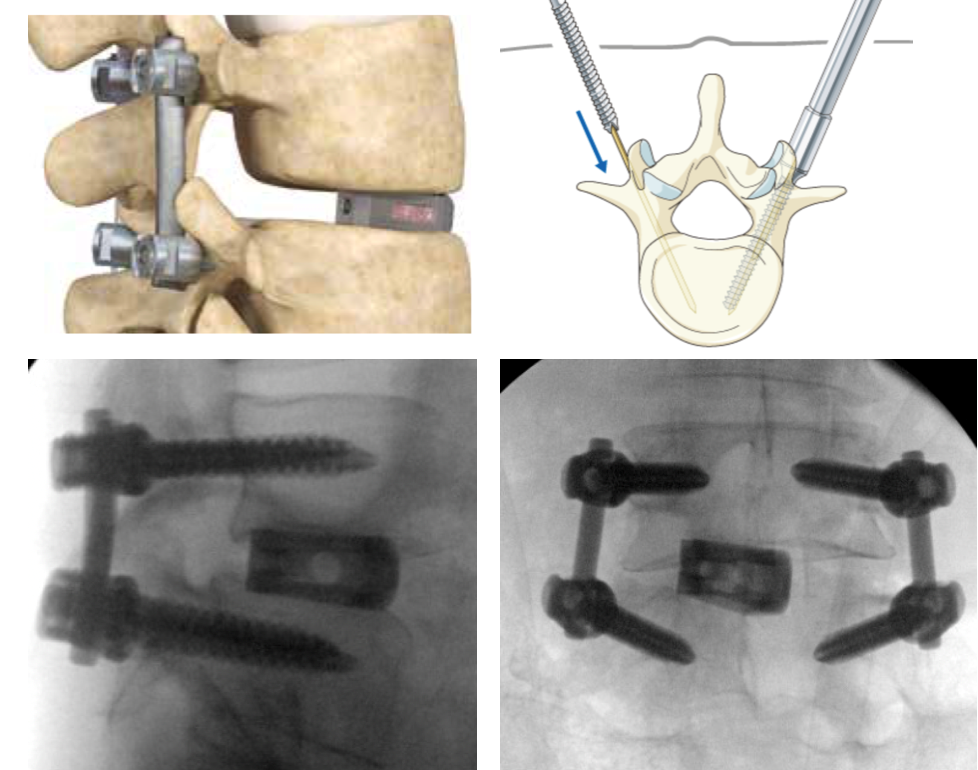Spine Surgery
Keyhole Spinal
Fusion Surgery
Keyhole Spinal Fusion Surgery
Keyhole Spinal Fusion Surgery
What is spinal fusion surgery?
- This is a procedure where one or more spinal levels are fixed with screws and rods to permanently stop them from moving
- It usually requires placing some fresh bone in the disc space and may require the insertion of a plastic or metal ‘cage’ for added stability
- The bones on either side of the disc space knit together over a period of 6 months to 1 year
- Here the fresh bone is like a slow setting concrete and the screws and rod are like the scaffolding that holds the concrete

What are the indications for spinal fusion surgery?
- Spinal fusion is usually done when the spinal segment has excessive mobility which is called ‘instability’
- Instability can be the cause of leg pain because the nerves between the bones can be pinched
- Instability can also cause back pain by damaging the jelly between the bones
- Spinal fusion surgery treats the above 2 issues by abolishing the movement at the spinal level
- Other indications for spinal fusion or stabilization would be when there is a fracture of the spine or there is a tumour of the spine


How is Spinal fusion surgery done?
- This involves the exposure of the relevant bony parts by stripping the muscle covering them
- Some of the bone is then removed to allow access to the disc in between the bones
- The disc is then removed as much as possible
- The space left behind is filled with fresh bone. Sometimes a plastic or titanium cage is also placed inside the disc space
- 2 screws are placed in each bone, 1 on each side of the midline
- These screws are then connected with rods which are tightened up so the spinal level is held rigidly

What is ‘Keyhole Spinal Fusion Surgery’?
- Spinal fusion can be done through smaller incisions that do not require the muscles to be completely stripped off the bone
- The screws and rods can be placed under Xray control or with computer aided navigation
- The removal of the disc and the placement of the cage is under microscope visualization

What are the advantages of ‘Keyhole Spinal Fusion Surgery’?
- Because of minimal muscle stripping, there is less bleeding and less pain after the surgery
- Less pain medication is usually required
- The return to function is quicker and the hospital stay is shorter
- There is less damage to the structures adjacent to the level that is being operated on

Are there any disadvantages to ‘Keyhole Spinal Fusion Surgery’?
- It usually requires that your surgeon be trained in these techniques
- The costs can be higher due to the use of specialized instruments
- The surgery may take longer
- Sometime, we may need to convert to normal open surgery for reasons of safety and if keyhole surgery is insufficient
Will my spine feel stiff after fusion surgery?
- While spinal fusion takes away movement at the level/s that are fused, the other levels are usually able to make up for this
- Because fusion surgery can improve your pain, your back movement may actually be better after fusion surgery
Do the screws need to be removed after some time?
- Usually there is no need to remove any of the screws after fusion surgery
- These screws may not trigger metal detectors at the airports, but you will still be provided with an official card to explain this if it happens






